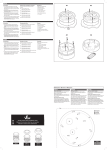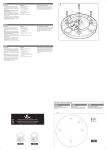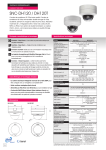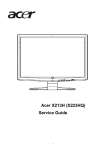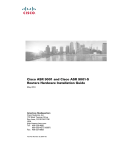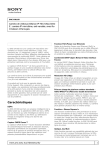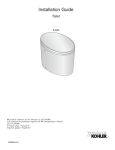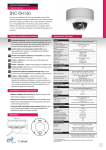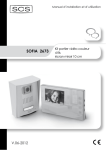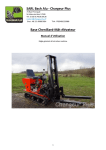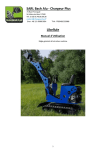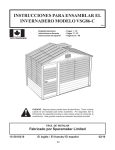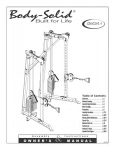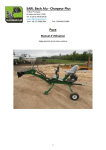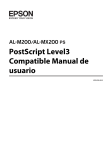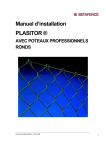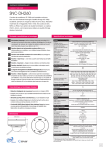Download A1 A2 A3 - deView Electronics
Transcript
Conector de cámara. ENGLISH Precautions Methods for mounting the enclosure Packing list • Do not attempt the disassemble the camera module mounted within the dome. There are no user-serviceable parts within the camera module. Refer servicing to qualified service personnel. There are three main ways to mount and fix the dome enclosures: In addition to this installation sheet: • Vandal dome enclosure A1: Flush mount without rear access • 4 x no.12 x 11⁄2” fixing screws • Handle the camera with care. Do not abuse the camera. Avoid striking or shaking it. Improper handling or storage could damage the camera. A2: Flush mount with rear access • 4 x Rubber sealing washers • Irrespective of whether the camera is in use or not, never face it towards the sun. Use caution when operating the camera in the vicinity of spotlights or other bright lights and light reflecting objects. Note: Always use the template provided. • 4 x Brown wall plugs A3: Normal surface mount using the outer ring • 2 x Ceiling clamp brackets • 2 x M4 x 40 screws When mounting externally • Power and video connection lead When mounting externally using the four base holes, use the supplied rubber washers (shown in A3) within the mounting holes to ensure moisture resistant seals. Also, ensure that the cable entry through either of the knockout panels A2 is suitably sealed against moisture ingress. • 1 x Torx key bit Précautions Montage du boîtier Contenu • Ne pas essayer de démonter le module caméra fixé à l’intérieur du dôme. Certaines parties du module caméra seraient détériorées. Attribuer l’entretien à un personnel qualifié. Il y a quatre types de montage pour la fixation des dômes : En plus du manuel d’instructions : • Dôme fixe anti-vandale • Do not operate the camera beyond its temperature, humidity or power source ratings. Use the camera under conditions where temperatures are within –5oC to +45 oC, and relative humidity is below 80% (non-condensing). A2 A1 FRANÇAIS A1 : Montage encastré sans accès arrière • 4 x no.12 x 11⁄2” vis de fixation A2 : Montage encastré avec accès arrière • Manipuler la caméra avec attention. Ne pas brusquer la caméra : éviter de la frapper ou de la secouer. Manipulation et stockage incorrect pourraient endommager la caméra. Ne jamais la positionner face au soleil. • Utiliser la caméra avec précaution lorsque celle-ci fonctionne aux alentours de projecteurs, lumières brillantes ou d’autres objets réfléchissants. • 4 x rondelle en caoutchouc A3 : Montage surface normal utilisant l’anneau extérieur • 4 x chevilles marrons Note : Toujours utiliser le gabarit de fixation. • 2 x vis M4x40 • 2 x supports d’attache pour plafond Pour le montage en extérieur Lors d’un montage à l’extérieur en utilisant les quatres trous de la base, utiliser les joints en caoutchouc fournis (montré sur A3) sur les trous de montage pour assurer l’étanchéité. Aussi, s’assurer que l’entrée du câblage aussi par les plaques de sécurité A2 est convenablement scellée contre l’entrée d’humidité. • 1 x clé Torx Precauciones Montaje de la caja Contenido • No intente desmontar el módulo de la caja sin el dome. No se suministran las partes del modulo de la cámara. Para servicios y reparaciones siempre utilice personal qualificado. Existen cuatro maneras de montar y fijar la caja : Además de éste manual de instrucciones • Vandal Dome • Maneje la cámara con cuidado. No abuse la cámara. No agitarla o golpearla. El úso inapropiado de la cámara podría dañarlo. A2: Montaje encajado con acceso trasero A3: Montaje sobre superficie utiliznado el anillo exterior • 4 x alcayatas marrones de pared • Independiemente de que la cámara se encuentre en uso o no, nunca la coloque de cara al sol. Utilícela con precaución en los focus de lúz, luces brillantes y objetos que reflejen lúz. Nota : Siempre utilizar l’esquema de fijación. • 2 x M4x40 tornillos Para el montaje de la camarà al exterior • 2 x ganchos para fijar en el techo • Ne pas faire fonctionner la caméra au-delà de ses limites de température, humidité ou puissance. Utiliser la caméra lorsque les températures sont entre -5°C et +45°C, et l’humidité relative en dessous de 80% (sans condensation). EN Ceiling clamp brackets x 2. • Câble de connexion vidéo et alimentation FR Supports d’attache pour plafond x 2. ES Ganchos para fijar en el techo x 2. A3 ESPAÑOL • No utilizar la cámara más allá de su temperatura, humedad y alimentación. Utilizar la cámara únicamente en condiciones de temperatura entre 5°C y 45°C y con relativa humedad, bajo 80% (sin condensación) A1: Montaje encajado sin acceso trasero • 4 x no.12 x 3’’ tornillos di fijación • 4 x arandella de goma Quando un montaje al exterior utilizando los cuatros agujeros de la base, utilizar los arandelas de goma suministradas (mostrada su A3) en los agujeros de montaje por cerrar herméticamente. Asegúrese que l’entrada de los cables ,también a través de los paneles A2, està cerrado de manera adecuada contro l’humedad. EN Rubber washers to create moisture seal when fixing externally. FR Rondelles en caoutchouc pour sceller contre l’humidité lors d’un montage à l’extérieur. ES Arandelas de goma por cerrar contro l’humedad cuando montaje al exterior. • Cable de conexión para alimentación y video. • 1 x llave Torx EN Template FR Schéma ES Esquema ENGLISH FRANÇAIS ESPAÑOL Surface mount Montage saillie Montaje superficie Create four holes of diameter 7mm at template positions ‘T1’. Use 4 x brown wall plugs and 4 x (no.12 x 11⁄2”) screws. When mounting externally, use a rubber washer at each mounting hole in the base to ensure moisture resistant seals. Flush mount Create an aperture in the mounting surface to a diameter of 110mm as indicated by ‘T5’. With rear access: Create two holes at template positions ‘T2’ of diameter 5mm. Use 2 x (M4 x 40) fixing screws and 2 x ceiling clamp brackets. Without rear access: Create two holes at template positions ‘T2’ of diameter 7mm and insert a brown wall plug into each. Use 2 x (no.12 x 11⁄2”) screws. Cable access (in all cases) Créer quatres trous de 7mm de diamètre en utilisant la position T1 du schéma. Utiliser 4 chevilles et 4 vis de (no.12 x 11⁄2”). Lors d’un montage à l’extérieur, utiliser une rondelle imperméable (joint d’étanchéité) sur chaque trou de la base pour assurer une clotûre hermétique. Montage encastré Créer une ouverture de 110mm dans la surface de montage comme indiqué par la position T5. Avec accès par l’arrière : Créer deux trous de 5mm de diamètre indiqué par la position T2. Utiliser les 2 vis de fixation (M4 x 40) et les 2 support d’attache pour plafond. Sans accès par l’arrière : Créer deux trous de 7mm de diamètre indiqué par la position T2. et introduire une cheville dans chaque. Utiliser deux vis de (no.12 x 11⁄2”). Accès du câblage (dans tous les cas) Use either the base knockout ‘T3’ or the internal side knock-out shown in fig E overleaf. Hole ‘T4’ may be used in conjunction with the outer ring when surface mounting to avoid opening the external knock-out. Utiliser le panneau de sécurité de la base T3 ou bien le panneau de sécurité intérieur (voir fig.E). Le trou T4 peut être utilisé en conjonction avec l’anneau du dôme lors d’un montage en surface pour éviter d’ouvrir le panneau de sécurité extérieur. Hacer cuatros agujeros de 7mm de diámetro utilizando la posición T1 del esquema. Utilizar 4 alcayatas y 4 tornillos de no.12 x 11⁄2”. Quando un montaje al exterior, utilizar arandelas de goma en los agujeros de montaje por cerrar herméticamente Montaje encajado Crear un abertura en la superficie de montaje con un diámetro de110mm como aparece indicado por la posición T5. Con acceso trasero: Hacer dos agujeros de 5mm de diámetro indicado por la posición T2. Utilizar los 2 tornillos de fijación M4 x 40 y los 2 ganchos para fijar en el techo. Sin acceso trasero: Hacer dos agujeros de 7 mm de diámetro indicado por la posición T2. Introducir alcayatas y utilizar dos tornillos de no.12 x 11⁄2”. Acceso de los cables (en cualquier caso) Utilizar el panelo de seguridad de la base T3 o el panelo de seguridad interior (mirar fig.E). El agujero T4 puede estar utilizado conjuntamento con l’anillo del dome cuando montaje in superficie por evitar de abrir el panelo de seguridad exterior. # FR ES Vandal resistant dome installation sheet Manuel d’instructions dôme fixe anti-vandale Manual de instrucciones vandal dome Document: SML PN0172 - 1.2 EN T4 FR T3 ES T1 T2 T5 T1 VP23W Template Schéma Esquema T2 T1 VP20W EN T1 VP20W VP23W ENGLISH E Installing the dome enclosure 1 Remove the dome cover E2 Use the supplied Torx driver to loosen (but not remove) the four cover screws. The screws will be held in place by the gasket. EN E1: Base knock-out; E2: Internal side knock-out. FR E1: Panneau de sécurité de base; E2: Panneau de securité intérieur. E1 2 Use the template to mark-out and prepare the mounting area ES E1: Panelo de seguridad de la base; E2: Panelo de seguridad interior. 3 Open the required knock-out panel Carefully drill (or tap out) either the base knock-out (E1) or internal side knock-out (E2) to the size required to allow cable entry. 4 Attach the dome enclosure to mounting holes E3 EN E3: Cable access without opening the external side knock-out; E4: Cable access via the external side knock-out. Using the supplied screws appropriate to the mounting surface, fix the dome enclosure (and outer ring, if necessary) to the prepared mounting area. IMPORTANT: If the dome is being mounted externally and using the four base holes, use the supplied rubber washers within each of the four mounting holes of the dome base to ensure moisture resistant seals. 5 Connect the wiring Insert the wiring through the knock-out hole, into the enclosure and connect to the small, or large, circuit board as fitted (fig F). The large circuit board offers two alternative ways to connect power and video cables: • Terminal strip - used for permanent bare wire connections, or • Supplied lead - used for permanent or temporary test connections. Note: Ensure that the cables remain clear of the camera rotation area. Cable types • Video cable - use a good quality coaxial cable with 75ohm impedance. • Power cable - use suitably insulated two-core cable capable of carrying 3W at 12VDC or 24VAC. IMPORTANT: If the dome is being mounted externally, use a suitable sealant around the cable access hole to ensure a moisture resistant seal. FR E3: Accès câbles sans ouvrir le panneau intérieur; 6 Fit the camera assembly Connect the camera to the small, or large, circuit board as fitted (fig G) and then place the camera chassis/gimbal bracket onto the three mounting pillars within the enclosure. Insert and tighten the three gimbal securing screws (fig H). Note: Gimbal screws are supplied with both the housing and the camera assembly (when supplied separately), therefore, you should have three screws left over. 7 Adjust the camera position and test Slightly loosen the three inner camera chassis locking screws (fig J) so that the camera chassis becomes free to move. Rotate and pan the camera chassis to the required position and then tighten the camera chassis locking screws to fix it in position. Note: For specific camera adjustments (i.e. focussing and settings), please see the Dome camera supplement sheet. 8 Replace the dome cover Ensure that the o-ring seal is in position, replace the dome cover and use the supplied Torx key to tighten the four cover screws - DO NOT OVERTIGHTEN. E4: Accès câbles par le panneau intérieur. ES E3: Acceso cables sin abrir el panelo interior; E4: Ac- ceso cables a través el panelo interior. FRANÇAIS Montage du boîtier E4 1 Enlever le couvercle supérieur Utiliser la clé « Torx » fournie pour déserrer (ne pas enlever) les quatres vis du couvercle. Les vis seront tenues en place par le joint. 2 Utiliser le gabarit (schéma) pour préparer la zone de montage. 3 Enlever les plaques de sécurité Enlever (ou percer) avec précaution la plaque de sécurité de la base (E1) ou intérieure (E2) à la taille nécessaire pour permettre l’entrée du conduit (câblage). F 4 Fixer le boîtier aux trous de montage EN F1: Power 12VDC or 24VAC; F2: Power 12VDC only; F3: Power Ground; F4: Video output. FR F1: Alimentation 12VDC ou 24VAC; F2: Alimentation 12VDC seulement; F3: Alimentation (terre); F4: Sortie vidéo. GN D VID ES F1: Alimentación 12VDC o 24VAC; F2: Alimentación solamente 12VDC; F3: Alimentación tierra; F4: Conector de video out. 0V 12 V F2 F1 F4 1 Quitar la cobertura del dome Utilizar la llave Torx incluida para aflojar (pero non quitar) los cuatros tornillos de la cobertura. Los tornillos quedarán sujetos por el anillo de goma. 2 Utilizar el esquema incluido para marcar y preparar el area de montaje EN G1: Camera connector. FR G1: Connecteur caméra. 3 Quitar los paneles G1 ES G1: Conector de la cámara. GN D VID 0V or ou o 12 V H H2 H2 EN Place the gimbal bracket and camera chassis (H1) onto the three mounting pillars. Insert and tighten the three gimbal securing screws (H2). FR Placer le support et chassis caméra (H1) sur les trois piliers de montage. Visser et serrer le support avec les trois de fixation (H2). ES Colocar el soporte y cámara (H1) sobre los tres pilares. Apretar el soporte con los tres tornillos de fixación (H2). H1 J1 J2 EN Loosen the three camera chassis locking screws (J1). Rotate and pan the camera chassis (J2) to the required position. Carefully tighten the three screws. FR Déserrer les vis de fixation du chassis caméra (J1). Effectuer les rotations horizontales et verticales (J2) nécessaires vers la position demandée. Pour bloquer, revisser les trois vis avec précaution. J1 J1 Connecter la caméra au petit ou grand circuit PCB principal installé (fig.G) et placer le support châssis de la caméra sur les trois piliers de montage à l’intérieur du boîtier. Introduire et serrer les trois vis de fixation (fig.H). Note : les vis de fixation sont fournies avec le boîtier et l’assemblage caméra (lorsque fournis séparemment). C’est pourquoi, vous devriez avoir trois vis de rechange. 7 Ajuster la position de la caméra Desserer légèrement les trois vis intérieures du support caméra. (fig.J) pour libérer le chassis. Effectuer les rotations horizontales et verticales nécessaires vers la position demandée. Resserer les trois vis antérieures pour fixer la caméra. Note : Pour les ajustements caméras (ex : mise au point, changement des caractéristiques,…) se référer à la documentation caméra. 8 Replacer le couvercle S’assurer que l’anneau-joint d’étanchéité est placé dans sa position, replacer le couvercle et ressere les quatres vis de couvercle en utilisant la clé « torx » - NE PAS SERRER TROP FORT. Montaje de la caja G J 6 Fixer l’assemblage de la caméra ESPAÑOL F3 G1 Introduire les fils de branchement à l’intérieur du dôme par la plaque de sécurité enlevée. Brancher au petit ou grand circuit PCB principal installé (fig.F). Le grand circuit PCB principal offre deux méthodes alternatives de branchement de l’alimentation et de la vidéo : • Bornier à vis : branchement permanent • Connecteur : branchement permanent ou temporaire (test) Note : S’assurer que les câbles reste à l’écart et ne gêne pas la rotation de la caméra. Types de câbles • Câble vidéo – Utiliser un câble coaxial de bonne qualité avec 75 ohm d’impédance. • Câble d’alimentation – Utiliser deux câbles convenablement isolés capables de transporter 3W à 12VDC ou 24VAC. IMPORTANT : Si le dôme est monté en extérieur, utiliser un enduit d’étanchéité approprié autour du trou d’accès du câblage afin de sceller hermétiquement le boîtier. F3 or ou o F4 Utiliser les vis fournies adéquates pour la surface de montage, fixer le boîtier (et anneau extérieur si nécessaire) sur la zone de montage préparée. IMPORTANT : Si le dôme est monté en extérieur et en utilisant les quantres trous de la base, utiliser les joints d’étanchéité fournis sur les quatres trous afin de sceller hermétiquement le boîtier. 5 Branchement ES Aflojar los tornillos de fixación del soporte cámara (J1). Rotare horizonl- tamente y verticalmente la cámara (J2) en la posición adecuada. Por bloquear, apretar los tres tornillos de fixación. Con mucho cuidado, quitar o empujar hacia fuera los paneles de la base (E1) o interna laterales (E2) a la medida apropriada por l’entrada del conducto (cable) 4 Fijar la caja a la superficie di montaje Utilizando los tornillos apropriados, fijar la caja a el área preparada de montaje (y anillo exterior si necesario). IMPORTANTE : Si el dome esta montado al exterior y utilizando los cuatros agujeros de la base, utilizar los arnadelas de goma suministrades en los cuatros agujeros por cerrar herméticamente la caja. 5 Conectar Introducir los cables al interior de la caja a través del tapone de seguridad quitado. Conectar al pequeño o grande circuito principale instalado (fig F). El grande circuito PCB prinicipale propone dos métodos alternativas de conexión del alimentación y video: • Terminal alineado: conexión permanenente • Toma : conexión permanente o provisional (prueba) Note : Asegurarse que los cables se encuentran fuera del área de rotación de la càmara. Tipos de cables • Cable de video – Utilizar un cable coaxial de buena calidad con 75ohm. • Cable di alimentación – Utiliser dos cables aislado adecuado y capaz de llevar 3W a 12VDC o 24VAC. IMPORTANTE : Si el dome esta montado al exterior, utilizar un producto impermeable por todas partes del agujero di accesso de los cables por cerrar herméticamente la caja. 6 Volver a colocar el montaje de la cámara Conectar la cámara a al pequeño o grande circuito principale PCB instalado (fig.G) y a continuaciòn colocar el soporte sobre los tres pilares que se encuentran dentro la caja. Volver a colocar y apretar los tres tornillos de fixaciòn (fig.H). Note : Los tornillos di fixaciòn estanno suministrados con la caja y la cámara (cuando suministrado por separado). E porque deberias tomarte tres tornillos de sobra. 7 Ajustar la cámara en posición. Aflojar un poquito los tres tornillos interiores que permitan el soporte moverse con libertad (fig.G). Colocarlo en la posición adecuada y apretar de nuevo los tres tornillos para fijar estar posición. Note : Referir a la “Page supplémentaire caméra dôme” por los adaptaciónes. (ex : Nivelar il campo di visión, ….). 8 Volver a colocar la cobertura del dome Asegurarse que el anillo de aislamento interior se encuentra en la posición adecuada. Colocar la cobertura y utilizar la llave Torx dada para apretar los cuatros tornillos – SIN PASARSE APRETANDO.


